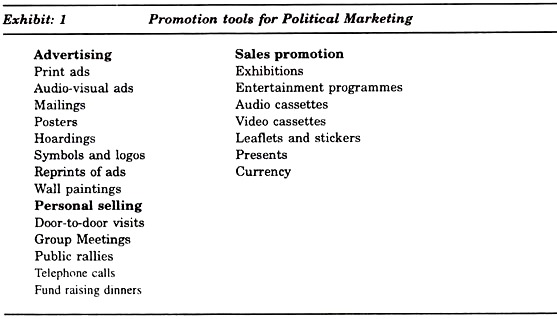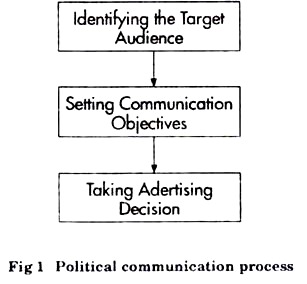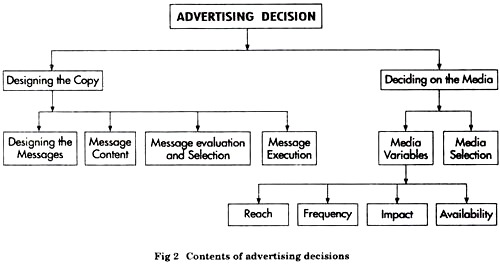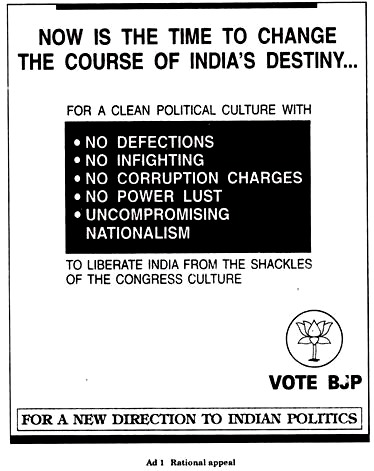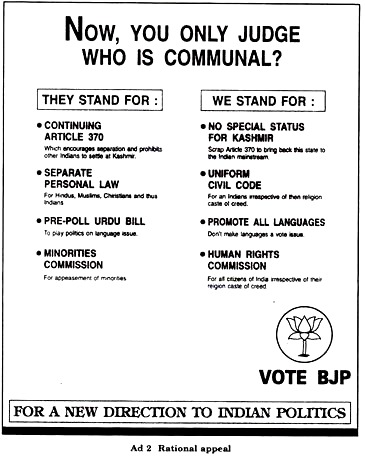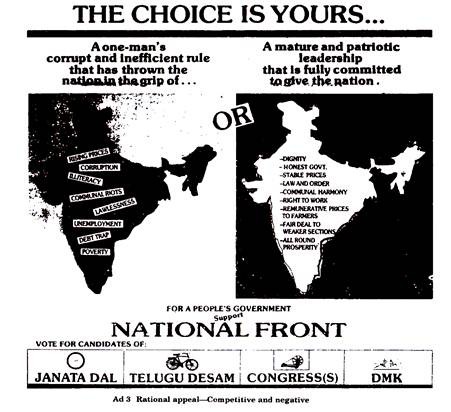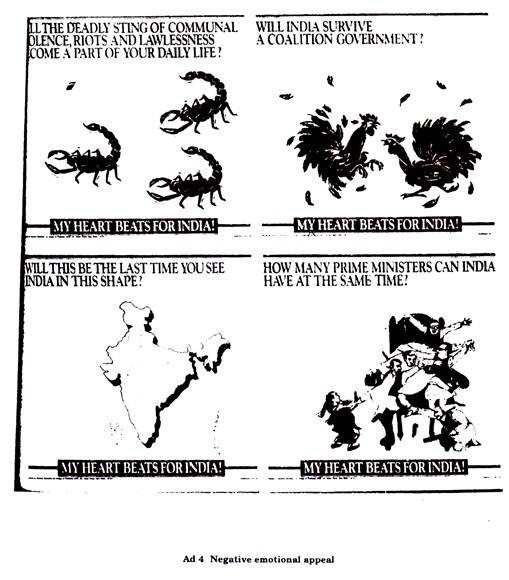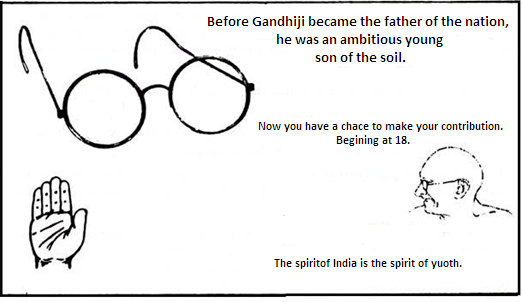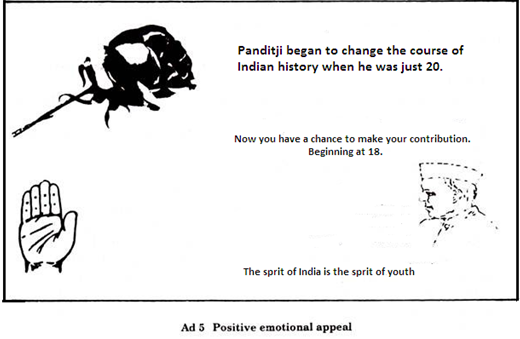As we know that whether it is product or service or a concept, communication play a very important role to increase the marketing effectiveness. This is equally applicable for profit as well as for non-profit organisations.
Advertising play a very important role in political marketing i.e. marketing for a political candidate. Persuasiveness is the key word in political advertising. Political parties have many option (promotion mix) to promote their candidates (Exhibit 1).
The selection of the various elements segmentally or jointly is done after taking into consideration the following factors:
(a) The Budget
(b) Objective of communication
(c) The voter size to be reached
(d) The party and the candidate
(e) The competition
(f) Effectiveness of each tool based on demography & geography.
Political Communication Process:
The political communication process involves the following steps (fig. 1):
Step-I:
Identifying the Target Audience:
The first step in political communication is to have a clear target audience in mind. It involves scanning of environment and go for market segmentation. It is very important to know the voter’s perception about the candidate as well as political party. The image perceived by the voters and the image which the party would like to project gives a prelude to setting communication objectives.
Step II:
Setting Communication Objectives:
Setting the communication objectives involves three fold setting of objective i. e. marketing objectives, party objectives and the communication objectives.
The marketing objectives may be:
1. Motivating the voters to vote for the party
2. Creating a favourable image as desired in the minds of the voters.
3. Airing a negative picture of the opposition party.
The party objectives may include:
(i) Coming to power by emerging the single largest party.
(ii) Aiming to become the major opposition party.
(iii) Winning a certain number of seats in the election.
Communication objectives may include:
(i) To convert non-voters into voters and winning over the competitor’s voters to the party.
(ii) To create the awareness about the party especially the name recognition. This can be accomplished with simple messages and repeating the name.
(iii) To communicate in such a way that target audience comes out on the day of election and vote the party to power.
(iv) To communicate to the target audience with the major issues at stakes.
The most important aspects of the communication in political marketing is that the communication results are directly measurable in terms of the vote casted by the voters
Step-III:
Taking Advertising Decision:
The advertising decision has to be taken based on the following procedure (fig. 2):
(a) Designing the Message:
Though there are certain standard approaches in designing the messages then also the designing of message is more an art than a science. Designing the message involves a lot of creativity. The message should get attention, hold interest, arouse desire and obtain action.
Formulating the message require getting answers to four questions:
1. What to say (message content)
2. How to say it logically (message structure)
3. How to say it symbolically (message format)
4. Who should say it (message source)
(b) Message Content:
Message content should have a appeal and that appeal if it is unique in nature can turn the fate of the candidate. The content will amount to formulating a benefit, motivation, identification promise and a reason why are voters should think or do as desired.
Message contents may have rational, emotional and moral appeal. Rational appeal show the voters that the party will fulfill the expectations. This appeal provides the reason to the voters for voting the our party. (Ad 1, 2, 3).
Emotional appeal attempts to stir up some negative or positive emotion that motivate voters. Positive appeal is in the form of pride, religion, patriotic etc. (Ad 5). Negative appeal shows the negative consequences if our party does not come to power (Ad 4).
Moral appeals are directed towards the voter’s sense of what is right and proper. These appeals are of tern used to urge people to support social causes such as cleaner environment, welfare of underprivileged, causes of women etc.
(c) Message Evaluation:
The messages formulated must be evaluated (pre testing) on the basis of desirability, exclusiveness and believability.
(d) Message Execution:
The impact of message depends upon not only what is said but also on how it is said. In political communication, knowing the common men’s problem and priorities, every political party can go for identical message execution.
So as the theme is more or less the same for all the political parties advertisements, the communicator has to put the message across in a way that first catches the attention of voters and evokes interest. This is where, the creative persons have t: find out the suitable style, tone, words and format for executing the messages.
Deciding about the Media:
As for the actual airing of the message, a channel (i.e. media) is required. Today the advertiser has a number of media to choose from which is called as media planning.
Contents of Media Planning are as follows:
(a) Media Variables
Media variables include:
(i) Reach
(ii) Frequency
(iii) Impact
(iv) Availability
Reach of the media means the total number of audience reached by the media or the number of voters exposed to a particular media schedule at-least once during a specified time period. The reach for print media is decided on the basis of its readership.
In case of radio, it is expressed in terms of listenership and of TV as viewership. As in political communication, a large number of voters are to be reached, only the mass media that has the largest reach should be preferred.
Frequency specifies the number of times within the specified time period an average voter is exposed to message. Impact is the qualitative value of an exposure through a given medium. As the national level newspaper has a better impact than a local or regional paper.
Availability of media means whether the media has the space to accommodate us or not. Availability of media can be understood by the booking of media (over booking, readily available or under booking).
(b) Media Selection:
A media planner has to know the capacity of the major media types to deliver reach, frequency and impact. Every medium has its strength and limitations & so as the purpose is to reach to the maximum number of voters, such media (or combination of various media) are to be selected so that there is less wastage.
Selection of the Advertising Agency:
Political advertising has come a long way from the days when the major media were hoarding, posters and bill boards. Today, the political advertising has become a complex science as well as art.
This is an account of the use of all possible promotion tools, availability of different media and using techniques like marketing research to measure the mood of the voters. The advertising agency in cooperation with the campaign manager develops the basic principles for the advertising campaign.
These principles have the following contents:
(i) The promotion mix to be developed and the allocation of budgets over different promotion tools.
(ii) The percentage of budget that will be spent in each week upto the election day.
(iii) The target voters who will be aimed at.
(iv) The ad sizes, colours and other details that will be made use of for print media.
(v) The types of illustrations that will be used.
(vi) The basic messages and the themes to be taken up.
While selecting the advertising agency, the following factors are to be considered:
1. The ad agency has not taken up work for other party or candidate.
2. Preferably, an agency, which believes in sharing the political ideology of the party.
3. As far as possible the total work of promotion should be awarded to one advertising agency and so the ad agency should be large enough to handle the affair.
4. An agency which can offer the total communication package under one roof. The service expected from the ad agency include marketing research, direct mail, print media a rosing, printing, computer facilities, outdoor advertising, audio and audio visual presentations etc.
Advertising Budget:
It is always very difficult to take a decision on how much to spend on promotion. As in consumer marketing, the expenditure on promotion is compensated by increased revenue, in political marketing there is nothing like earning a revenue. By winning, it” can only give political power to the party.
While deciding the advertising budget, the party has to scan the present environment and then it has to decide the budget after taking into consideration the following factors:
(i) The affordability
(ii) The competitor’s budget
(iii) The voters perception
(iv) The objective of advertising
(v) The cost of media
(vi) The time of promotion.
In political advertising, there is every likelihood that a voter may like an advertising campaign of one party merely for its creativity. However, if he is loyal member of the opposite party, how so ever, effective that campaign, he will never vote for it.
